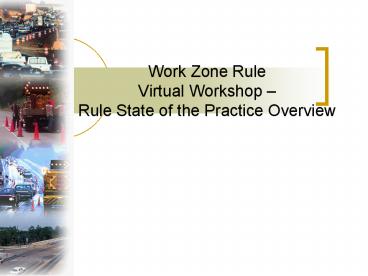Work Zone Rule Virtual Workshop - PowerPoint PPT Presentation
Title:
Work Zone Rule Virtual Workshop
Description:
Work Zone Rule Virtual Workshop Rule State of the Practice Overview Assessing the State of the Practice FHWA has identified several ways to assess the state of ... – PowerPoint PPT presentation
Number of Views:121
Avg rating:3.0/5.0
Title: Work Zone Rule Virtual Workshop
1
Work Zone Rule Virtual Workshop Rule State of
the Practice Overview
2
Assessing the State of the Practice
- FHWA has identified several ways to assess the
state of the practice and effects of the Rule - Review of 2008 Work Zone Self Assessment (WZSA)
results - Review of responses to five supplemental
questions added to the 2008 WZSA - Discussions with State and local agencies
3
What have we learned?
- Rule has brought about positive changes in
practices and more focus on managing work zones,
specifically in the following areas - Work Zone Policy
- Impacts Assessment
- Significant Project Identification
- Training
- TMP Development and Implementation
- Data Collection and Analysis
4
2008 WZSA Results
- Largest increases were in practices related to
Subpart J - Classifying projects based on impacts
(Significant Projects) 25 - Training law enforcement personnel 21
- Establishing a policy to develop TMPs 20
5
WZSA Rule Supplemental Questions
- Supplemental question scoring scheme
6
Work Zone Policy
- Biggest change - Agencies have pulled together
several disparate policy documents and
procedures/guidelines into one WZ
policy/guidelines. - Some agencies did not have a policy for MOT in
work zones and have now developed one as a result
of the Rule.
- 21 agencies (41) have reported that as a result
of their WZ Policy, they are taking a more
consistent approach to planning, designing, and
constructing road projects
7
Work Zone Policy (cont.)
- Many agencies mentioned they are now considering
WZ impacts earlier in the project development
process. - Some agencies have established goals and measures
for WZ performance (e.g., queues, delay time) as
a result of the Rule.
8
Impacts Assessment
- The agency is seeing enhanced consideration and
management of WZ safety and mobility impacts -
starting during planning and continuing through
project completion
- 24 agencies (47) experienced this as a result of
the Rule - 3 of those agencies cited the Rule as causing a
significant change in this area
9
Impacts Assessment (cont.)
- While planning and designing road projects, the
agency is expanding planning beyond the project
work zone itself to address corridor, network,
and regional issues particularly when
congestion is an issue.
- 19 agencies said the Rule had caused this to
occur - 17 agencies said the Rule had not caused change
because most of those agencies (16) were already
doing this
10
Impacts Assessment (cont.)
- Agencies also indicated that they are more often
using analytical tools to determine WZ impacts - 10 to 15 increase in score each of the past 2
years on the 2 related WZ SA questions - During planning to assess impacts of future
construction/maintenance activities - To assess impacts when developing TCPs
11
Significant Project Identification
- Agencies are thinking more about project impacts
and are more likely to have a process in place to
classify projects based on expected impacts - As a result, they are better able to assess and
manage WZ impacts - WZ SA shows a 25 increase in score between 2007
and 2008 in this area - Several States said that they organize a team to
develop the plan for mitigating the impacts of
significant projects
12
Training
- Training has been significantly affected by the
Rule - 27 agencies (53) said that as a result of the
Rule they had updated/changed training for their
staff (designers, planners, construction staff,
etc.) to address broader consideration of WZ
impacts and management in the scheduling, design,
and implementation of projects - 11 of those agencies said they had made
significant changes in training - WZ SA question on law enforcement training saw a
21 increase in score from 2007 to 2008
13
Training (cont.)
- The agency has updated/changed training for its
staff (designers, planners, construction staff,
etc.) to address broader consideration of work
zone impacts and management in the scheduling,
design, and implementation of projects.
14
TMP Development and Implementation
- Most agencies (90) now have a policy for
developing TMPs to help manage the WZ impacts of
a project - WZ SA shows a major score increase (20) from
2006 to 2007 and again from 2007 to 2008 - Some agencies have developed TMP teams and tools
15
Use of TMP Strategies
- The agency is expanding WZ management beyond
traffic safety and control to address mobility
through the consideration and use of
transportation operations (TO) and public
information (PI) strategies.
16
Data Collection and Analysis
- Increasing number of agencies report they are
establishing measures and collecting data to
track WZ congestion and delay - Likely related to the addition of operational
data to data provision when the Rule was updated - Agencies establishing measures to track WZ
congestion and delay increased 26 (from 23 to 29
agencies) between the 2007 and 2008 WZ SA, which
continued a significant increase of the year
before - WZ SA indicates a 21 score increase between 2006
and 2007 and a 15 increase from 2007 to 2008 for
the question on collecting data to track WZ
congestion and delay - Several agencies have started tracking queues































